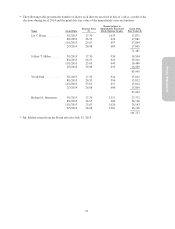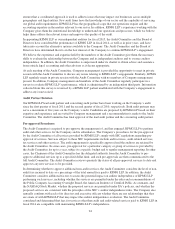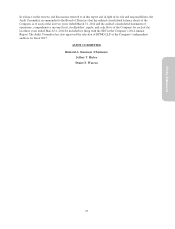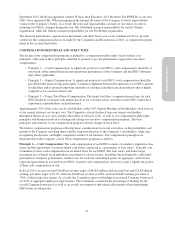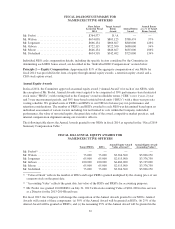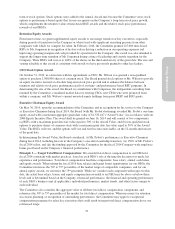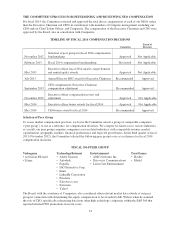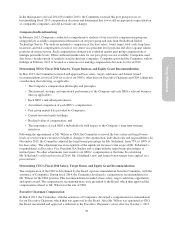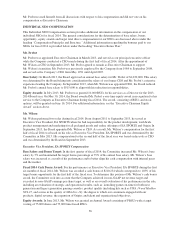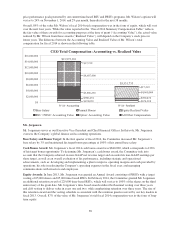Electronic Arts 2014 Annual Report Download - page 37
Download and view the complete annual report
Please find page 37 of the 2014 Electronic Arts annual report below. You can navigate through the pages in the report by either clicking on the pages listed below, or by using the keyword search tool below to find specific information within the annual report.
Proxy Statement
September 2013, the Board appointed Andrew Wilson, then Executive Vice President, EA SPORTS, as our new
CEO. Once appointed, Mr. Wilson reorganized the internal divisions of the Company to better align with his
vision for the Company’s future. As a result, the roles and responsibilities of many of our senior executives,
including two NEOs, changed during the year. Mr. Söderlund assumed responsibility for our EA Studios
organization, while Mr. Gibeau assumed responsibility for our EA Mobile organization.
The financial performance, operational achievements and other fiscal year events summarized above, provide
context for the compensation decisions made by the Committee and Board in fiscal 2014, as explained in greater
detail in the sections that follow.
COMPENSATION PRINCIPLES AND STRUCTURE
The design of our compensation programs is guided by a compensation philosophy based on three core
principles, with each of these principles intended to promote a pay-for-performance approach to executive
compensation:
• Principle 1 — Cash Compensation: A significant portion of each NEO’s cash compensation should be at
risk based on the annual financial and operational performance of the Company and the NEO’s business
unit, where applicable;
• Principle 2 — Equity Compensation: A significant portion of each NEO’s total compensation should be
provided in the form of long-term equity to enhance alignment between the interests of our NEOs and our
stockholders and to promote long-term retention of a strong leadership team in an industry that is highly
competitive for executive talent; and
• Principle 3 —Target Total Direct Compensation: The target total direct compensation package for each
NEO should be consistent with market practices for executive talent, and reflect each NEO’s individual
experience, responsibilities and performance.
Approximately 92% of the votes cast by stockholders at the 2013 Annual Meeting of Stockholders voted in favor
of our annual advisory say-on-pay vote. The Committee solicits feedback from our largest stockholders
throughout the fiscal year, and considers the results of advisory votes, as well as our compensation philosophy,
principles and business needs in evaluating and setting our executive compensation programs. The basic
principles and structure of our compensation programs did not change in fiscal 2014.
We believe compensation programs reflecting these considerations focus our executives on the profitability and
growth of the Company and align them with the long-term interests of the Company’s stockholders, while also
recognizing the dynamic and highly competitive nature of our business. Our compensation principles are
demonstrated in the Company’s fiscal 2014 compensation programs as follows:
Principle 1 — Cash Compensation: The cash compensation of each NEO consists of a market competitive base
salary and the opportunity to earn an annual cash bonus, expressed as a percentage of base salary. Typically, our
Committee reviews cash compensation on an annual basis for each NEO. The base salary and bonus target
percentage are set based on an individual assessment of various factors, including, but not limited to: individual
performance, Company performance, market rates for each role and internal parity. In aggregate, cash bonuses
represent approximately one-half of our NEOs’ targeted cash compensation, and serve to put a significant portion
of their cash compensation at risk.
In fiscal 2014, we met our non-GAAP net revenue target of $4,005 million and exceeded our non-GAAP diluted
earnings per share target of $1.30, with non-GAAP net revenue at 100% and non-GAAP earnings per share at
130% of their respective targets. As a result, the Committee approved funding of an overall Company bonus pool
at 115% of aggregate employee target bonuses. The Committee considered the percentage of funding for the
overall Company bonus pool, as well as an overall assessment of individual achievements when determining
NEO bonus award payouts.
31


